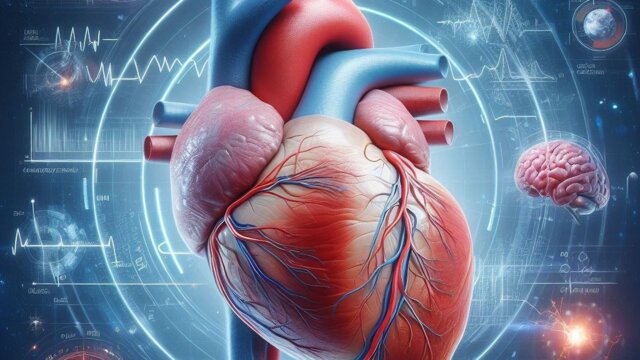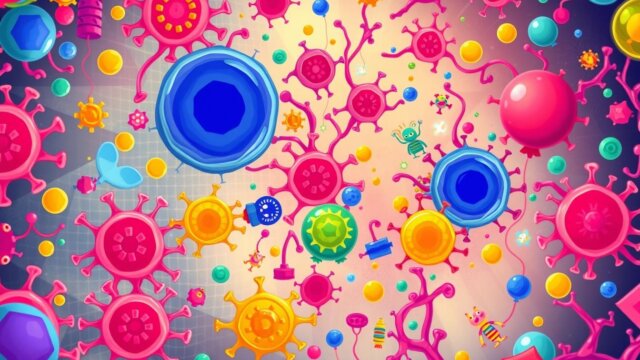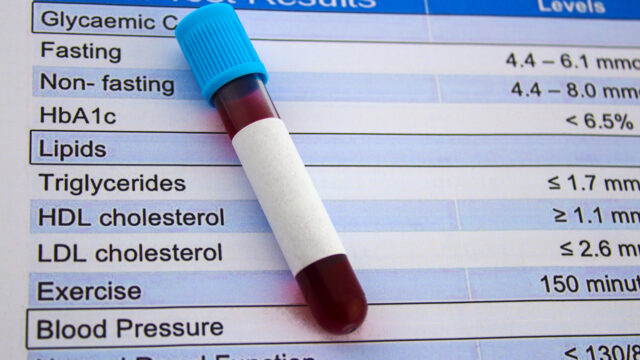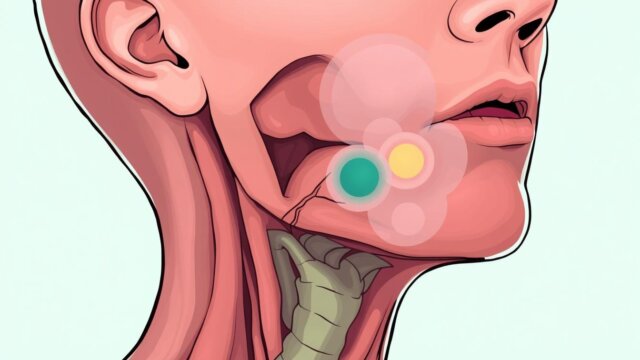FTC disclaimer: This post may contains affiliate links and we will be compensated if you click on a link and make a purchase.
Glioma is a brain tumor that starts in glial cells. It affects about 150,000 people in the U.S. every year. These tumors make up about 33% of all brain tumors, which is a big deal in neuro-oncology.
Gliomas can grow slowly or very fast. The fast-growing ones, like glioblastoma multiforme, are very aggressive.
Gliomas are more common in men and Caucasians than in women and African Americans. They can happen to anyone, but most often in adults. The average age of death from brain cancers is 64 years old.
It’s important to know about glioma. This helps doctors and patients understand brain cancer better.
Key Takeaways
- Glioma is a common type of brain tumor that originates in the glial cells.
- Gliomas account for approximately 33% of all brain tumors.
- Gliomas can range from slow-growing, low-grade lesions to rapidly progressing, high-grade malignancies.
- Gliomas are slightly more common in men and Caucasians.
- The median age of death from brain and nervous system cancers is 64 years old.
What is a Glioma?
A glioma is a brain tumor that starts in glial cells. These cells help the brain’s neurons work right. Gliomas grow inside the brain and can mix with normal brain tissue. They can grow slowly or quickly, and their type affects treatment and how well you might do.
Definition and Overview
Gliomas make up about 33 percent of brain tumors. They happen more in men than women and are more common in white people than black people. The chance of getting a glioma goes up with age, especially for people between 45 and 65.
Prevalence and Statistics
Gliomas are a common type of brain tumor. Astrocytomas are the most common, making up almost half of all brain tumors. Glioblastoma multiforme is the most serious brain tumor. In kids, gliomas like ependymomas make up 8 percent to 10 percent of brain tumors. Oligodendrogliomas are less common, but more likely in men.
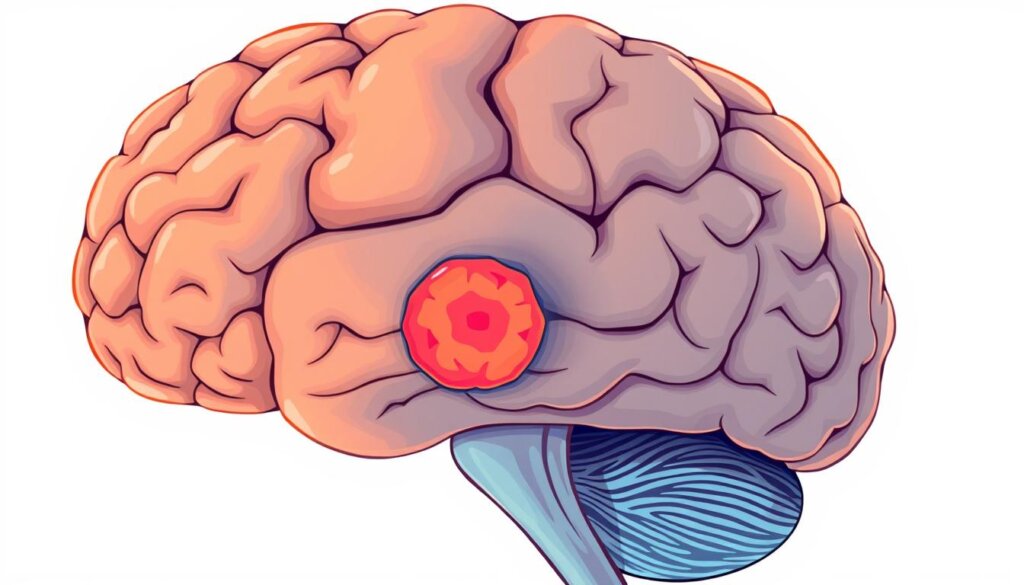
Gliomas can be slow-growing or fast-growing. Slow-growing gliomas can turn into fast-growing ones. Types include astrocytoma, oligodendroglioma, brain stem glioma, and ependymoma.
“Gliomas are caused by changes in glial cells’ functions.”
Types of Gliomas
Gliomas are brain tumors that come from different types of glial cells. Knowing the types helps doctors diagnose and treat them better. Let’s look at the main glioma types and what makes them unique.
Astrocytomas
Astrocytomas are the most common glioma, making up nearly half of brain tumors. They grow from astrocytes, brain cells that support other cells. The worst kind is glioblastoma multiforme, the top brain tumor in adults.
Brain Stem Gliomas
Brain stem gliomas, or DIPGs, are rare and found in the brain stem. They are hard to remove because they blend with normal brain tissue. This makes them a big cause of death in kids.
Ependymomas
Ependymomas grow from cells lining the brain’s ventricles or spinal cord. They’re rare, making up 2-3% of brain tumors, but common in kids. They can spread through cerebrospinal fluid.
Mixed Gliomas
Mixed gliomas, or oligo-astrocytomas, have more than one type of glial cell. Their exact classification is still debated and may depend on genetic tests. They’re found in the cerebrum and are common in adult men.
Oligodendrogliomas
Oligodendrogliomas come from oligodendrocytes, brain cells, and are found in the cerebrum. They make up 2-4% of brain tumors and are common in young and middle-aged adults, especially men. Seizures are a common symptom.
Optic Pathway Gliomas
Optic pathway gliomas are low-grade tumors in the optic nerve or chiasm. They can cause vision loss and hormone problems. People with neurofibromatosis are more likely to get them.
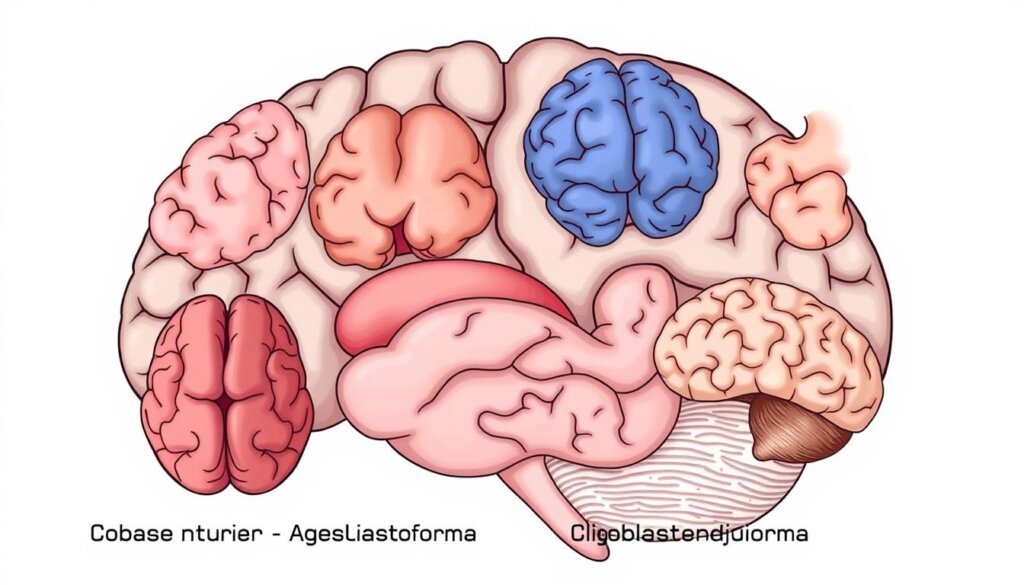
Glioma Symptoms
Gliomas are types of brain tumors. They can cause many concerning symptoms by pressing on the brain or spinal cord. Common symptoms include headaches, seizures, and changes in personality.
Other symptoms include weakness in arms, face, or legs, numbness, and speech problems. You might also feel nausea, vomiting, vision loss, and dizziness.
Glioblastoma, a very aggressive glioma, shows similar symptoms but slowly at first. Symptoms include severe headaches, nausea, and vomiting. You might also feel confused, have memory loss, and changes in vision or speech.
Balance issues, muscle weakness, and seizures are also symptoms. The symptoms of glioma depend on the tumor’s type, size, and location. Low-grade gliomas mainly affect speech, vision, and motor functions.
High-grade gliomas cause more severe symptoms that get worse fast.
If you or a loved one has any persistent or concerning neurological symptoms, seek medical help right away. Early detection and treatment can improve the disease’s course and quality of life.
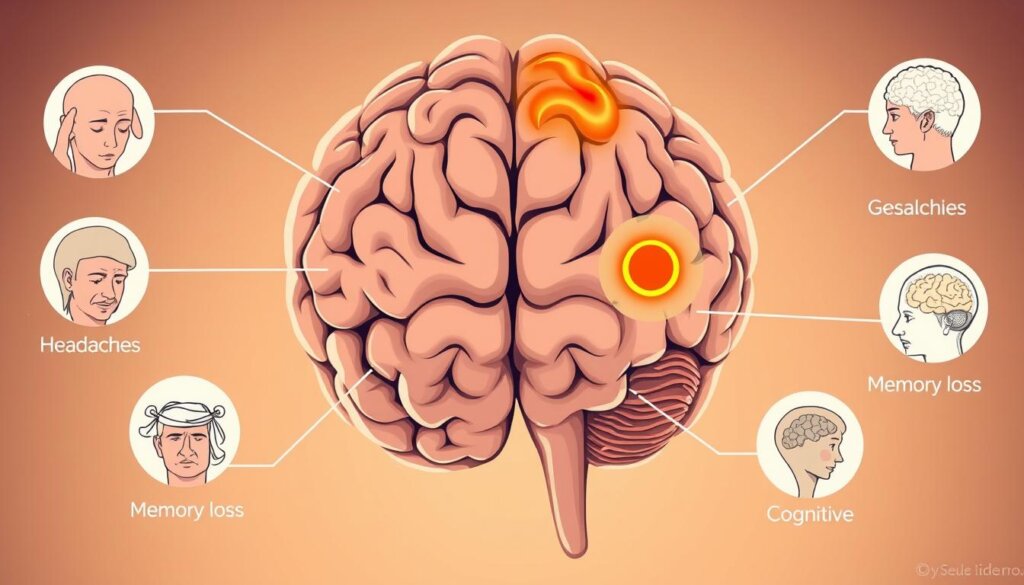
Risk Factors for Glioma
Gliomas are brain tumors that can happen to anyone, but they mostly hit adults between 45 and 65. They are a bit more common in men than in women.
Being exposed to ionizing radiation, like in cancer treatment, raises your glioma risk. This is especially true for those who got head radiation as kids for other cancers.
Some families might see more gliomas, but it’s rare. Certain genetic syndromes, like Turcot syndrome, can also up your risk.
Risk Factor | Description |
|---|---|
Age and Gender | Gliomas are most common in adults between the ages of 45 and 65, and slightly more likely to affect men than women. |
Radiation Exposure | Exposure to ionizing radiation, such as that used in radiation therapy for cancer treatment, can increase the risk of developing a glioma. |
Family History | Gliomas can run in families, but this is rare. Certain genetic syndromes can also increase the risk of gliomas and other brain tumors. |
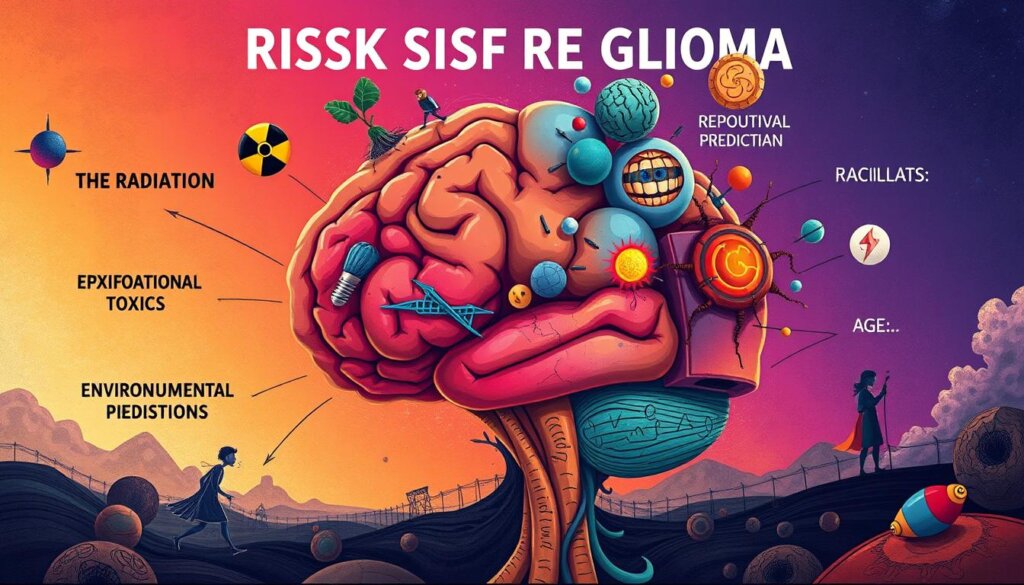
“Glioma risk is associated with the extent of estimated European genetic ancestry in African-Americans and Hispanics.”
Researchers are still looking into other possible risks, like cell phone use and chemicals. They need more studies to be sure.
Knowing about glioma risks helps with early detection and treatment. If you’re worried, talk to your doctor.
Diagnosing Glioma
Diagnosing a glioma, a brain tumor, needs a detailed approach. Your team will start by taking a thorough medical history. They will ask about any symptoms you have.
Symptoms can include headaches, weakness, seizures, vision changes, memory loss, or balance problems.
Physical and Neurological Exams
Your doctor will then do a physical exam and a detailed neurological assessment. The neurological exam checks brain functions like vision, hearing, and memory. It helps find out if the glioma is affecting the brain.
Imaging Tests
Your doctor will also order imaging tests, like MRI and CT scans. These scans show detailed images of the brain. At Perlmutter Cancer Center, they use advanced MRI techniques to understand gliomas better.
Biopsy
If tests suggest a glioma, a biopsy might be needed. This involves removing a small tumor tissue sample for examination. Stereotactic biopsy is often used for this.
The biopsy results confirm the diagnosis and the type of glioma.
At Perlmutter Cancer Center, doctors do precision molecular DNA testing. This gives a precise molecular diagnosis for each glioma. It helps predict prognosis and guide treatment.
Your healthcare team uses all this information to understand your glioma. They then create a treatment plan just for you.
Glioma Treatment Options
Treating gliomas, a type of brain tumor, involves a multifaceted approach. This may include surgery, radiation therapy, and chemotherapy. The goal is to provide the best possible outcome for each patient.
Surgery
Surgery is often the first line of treatment for gliomas. MSK neurosurgeons operate on hundreds of people with brain tumors each year. They have a lot of experience in performing brain surgeries for gliomas.
The surgical approach, known as a craniotomy, involves opening the skull. This allows them to access and remove as much of the tumor as possible. It helps relieve pressure on the brain and provides tissue samples for further analysis and diagnosis.
Radiation Therapy
Radiation therapy is commonly used in combination with surgery or when surgery is not possible. Different types of radiation therapy may be employed based on the specific needs of the patient and the characteristics of the glioma. The study by Stupp et al. in 2005 reported on the effectiveness of radiotherapy plus concomitant and adjuvant temozolomide for glioblastoma, a type of high-grade glioma.
Chemotherapy
Chemotherapy is often recommended for high-grade gliomas, typically after surgery and radiation therapy. The work of Esteller et al. in 2000 investigated the inactivation of the DNA-repair gene MGMT and its impact on the clinical response of gliomas to alkylating agents, which are a type of chemotherapy. Oral medications like temozolomide and targeted therapies may be part of the chemotherapy regimen, tailored to the individual patient and tumor characteristics.
Vorasidenib, a targeted therapy drug, was approved by the U.S. FDA in 2024 for treating low-grade diffuse gliomas with a specific gene mutation known as isocitrate dehydrogenase (IDH). This represents a significant advancement in treatment options for this specific type of glioma.
Some research studies suggest immunotherapies like checkpoint inhibitors, such as pembrolizumab (Keytruda®) and nivolumab (Opdivo®), could be future treatment options for gliomas. This highlights ongoing developments in treatment approaches for glioma patients. The first systemic treatment option for low-grade glioma in over 20 years was introduced with vorasidenib, reflecting a recent milestone in glioma treatment advancements.
The goal for high-grade gliomas is to extend the time before tumor regrowth after surgery. This indicates the focus on improving outcomes and prolonging remission periods for patients with aggressive tumors. MSK offers comprehensive resources for glioma patients post-treatment. This includes support for physical, emotional, and practical aspects such as pain management, nutritional guidance, exercise programs, integrative medicine therapies, and support for sexual health and fertility concerns among survivors.
Understanding Glioblastoma
Glioblastoma, also known as glioblastoma multiforme (GBM), is the most aggressive brain cancer. This high-grade astrocytoma grows fast and can spread to healthy brain tissue. It’s the most malignant brain tumor. New research offers hope for treatments, but glioblastoma is still a tough opponent.
Gliomas are brain tumors from glial cells, making up 81% of primary malignant brain tumors. Glioblastomas are the most aggressive type. Low-grade gliomas are rare, making up only 20% of diagnoses. High-grade gliomas grow fast and are hard to treat.
Glioblastoma multiforme tumors are the toughest glioma to treat. They don’t spread to other organs but can invade nearby brain tissues. This makes them hard to remove surgically.
Getting a correct and timely diagnosis is key for glioma treatment. Getting a second opinion from a specialist like Dr. Aaron Cohen-Gadol can offer new treatment options and reassurance.
Glioma Type | Grade | Characteristics |
|---|---|---|
Anaplastic astrocytoma | Grade III | A malignant glioma that is less aggressive than glioblastoma. |
Anaplastic oligodendroglioma | Grade III | A relatively rare type of oligodendroglioma. |
Knowing about glioblastoma’s unique traits and challenges is the first step in fighting this aggressive brain cancer. With ongoing research and specialized care, patients and their families can find hope and support in their battle against this tough disease.
Glioma Care at Mayo Clinic
Mayo Clinic is a top place for glioma and brain tumor care. They have teams of experts in many fields working together. This helps them make treatment plans that fit each patient’s needs.
Every year, Mayo Clinic helps over 3,000 adults and kids with glioma brain tumors. Their neurosurgeons do many brain tumor surgeries. This shows their skill and experience.
Mayo Clinic is also a National Cancer Institute-designated comprehensive cancer center. This means they meet high standards for cancer care. They focus on preventing, diagnosing, and treating cancer.
At Mayo Clinic, getting an evaluation and treatment can take just days. This is because of the team’s expertise. They use the latest techniques to treat glioblastoma.
Mayo Clinic offers many treatments for glioblastoma. This includes new types of radiation therapy. They also use computer-assisted surgery and laser surgery.
Mayo Clinic is known for its top-notch neurology and neurosurgery care. It’s also ranked high for cancer care. The Mayo Clinic Children’s Center in Rochester is the best in Minnesota and the surrounding states for kids’ hospitals.
Mayo Clinic is a leading place for glioma patients. They offer a comprehensive approach and the latest treatments. This makes Mayo Clinic a top choice for care.
Conclusion
Gliomas are brain tumors that start in glial cells. They have many types, symptoms, and treatments. Knowing about gliomas helps patients and their families make good choices for their care.
Glioblastoma (GBM) is the most common and aggressive glioma. It affects more men and Caucasians in the U.S..
Glioma growth is linked to normal brain cell paths. Important molecules like NFIA, SOX9, and Olig2 help in glioma development. Even though glioblastoma is hard to treat, new treatments are showing hope, especially for secondary glioblastomas.
Getting care at a place like Mayo Clinic is key for glioma patients. Knowing about glioma overview, brain tumor overview, and key takeaways in research helps patients and families.
FAQ
What is a glioma?
A glioma is a brain tumor that starts in glial cells. These cells support the brain’s neurons.
How common are gliomas?
Gliomas make up about 33% of brain tumors. They are more common in men than women. They also happen more in Caucasians than in African Americans.
What are the different types of gliomas?
The main types include astrocytomas, brain stem gliomas, and ependymomas. There are also mixed gliomas, oligodendrogliomas, and optic pathway gliomas.
What are the symptoms of a glioma?
Common symptoms are headaches and seizures. You might also notice personality changes, weakness, or numbness. Problems with speech, nausea, vomiting, vision loss, and dizziness are also symptoms.
What are the risk factors for developing a glioma?
Risk factors include age, with most cases in adults 45-65. Men are slightly more at risk. Exposure to ionizing radiation is also a risk factor.
How are gliomas diagnosed?
Diagnosis starts with a medical history and physical exam. A neurological exam and brain imaging tests like MRI and CT scans are used. A biopsy confirms the diagnosis and type of glioma.
What are the treatment options for gliomas?
Treatment options include surgery, radiation therapy, and chemotherapy. The plan is tailored to the patient and tumor. Often, a combination of these treatments is used.
What is glioblastoma?
Glioblastoma is the most aggressive brain cancer. It is a high-grade astrocytoma. It grows fast and can spread to healthy brain tissue.
Why is the Mayo Clinic a leader in glioma care?
Mayo Clinic is a top provider of glioma care. They have teams of experts working together. They create personalized treatment plans and offer the latest therapies and clinical trials.




